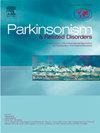免疫细胞、代谢物与帕金森病之间的潜在因果关系:一项中介孟德尔随机化研究
IF 3.4
3区 医学
Q2 CLINICAL NEUROLOGY
引用次数: 0
摘要
几项研究表明免疫细胞与帕金森病(PD)之间存在潜在联系。然而,它们之间确切的因果关系,以及代谢物在这方面的模糊中介功能,在很大程度上仍未明确。方法通过大规模全基因组关联研究(GWAS)的大量汇总数据分析,确定了免疫细胞、代谢物和PD。为了深入研究这些因素之间的因果关系,我们采用了孟德尔随机化(MR)技术。我们的主要统计方法是逆方差加权(IVW)。此外,我们研究了代谢物是否在连接免疫细胞与PD的途径中起中介作用。结果免疫细胞遗传易感性与PD之间存在16个正向因果关系,14个负向因果关系。同样,代谢物与PD之间有19个正因果关系和21个负因果关系。此外,我们的研究结果表明,CD11c+ HLA-DR++单核细胞%单核细胞和CD14+ CD16+单核细胞上的CD16通过升高鞘磷脂(d17:2/16:0, d18:2/15:0)水平对PD产生不利影响。结论本研究强化了免疫细胞与PD风险之间的联系,同时阐明了鞘磷脂在这些因素之间的因果关系中的介导作用。本文章由计算机程序翻译,如有差异,请以英文原文为准。
Potential causal association between immune cells, metabolites and Parkinson's disease: A mediation Mendelian randomization study
Background
Several studies have indicated a potential link between immune cells and Parkinson's disease (PD). However, the precise causal relationship between them, along with the ambiguous mediatory function of metabolites in this connection, remains largely undefined.
Methods
Immune cells, metabolites, and PD have been identified through extensive analysis of summary data from large-scale genome-wide association studies (GWAS). To delve deeper into the causal relationships among these factors, we employed Mendelian randomization (MR) techniques. Our primary statistical approach was inverse variance weighting (IVW). Furthermore, we investigated whether metabolites serve as a mediator in the pathway connecting immune cells to PD.
Results
We observed 16 positive and 14 negative causal effects between the genetic predisposition of immune cells and PD. Similarly, there were 19 positive and 21 negative causal relationships identified between metabolites and PD. Furthermore, our results indicate that CD11c+ HLA-DR++ monocyte %monocyte and CD16 on CD14+ CD16+ monocyte exert adverse effects on PD by elevating Sphingomyelin (d17:2/16:0, d18:2/15:0) levels.
Conclusions
This study reinforces the link between immune cells and the risk of PD, while simultaneously elucidating the mediating role of Sphingomyelin in the causal relationship between these factors.
求助全文
通过发布文献求助,成功后即可免费获取论文全文。
去求助
来源期刊

Parkinsonism & related disorders
医学-临床神经学
CiteScore
6.20
自引率
4.90%
发文量
292
审稿时长
39 days
期刊介绍:
Parkinsonism & Related Disorders publishes the results of basic and clinical research contributing to the understanding, diagnosis and treatment of all neurodegenerative syndromes in which Parkinsonism, Essential Tremor or related movement disorders may be a feature. Regular features will include: Review Articles, Point of View articles, Full-length Articles, Short Communications, Case Reports and Letter to the Editor.
 求助内容:
求助内容: 应助结果提醒方式:
应助结果提醒方式:


